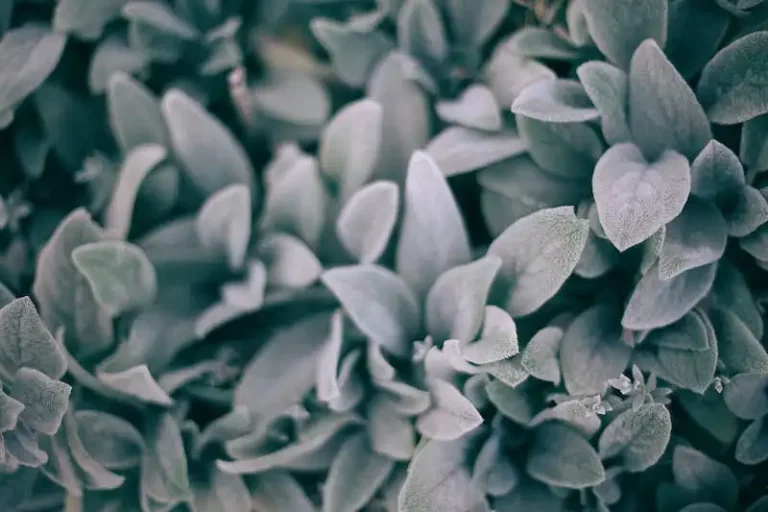A meticulously grown, well-maintained garden can kick the aesthetics game of your home up a notch, and as explained by Home Light, increase the resale value of your property. But it all boils down to planting the right species of flowers. Therefore, whether you’re just a hobbyist playing around with flower ideas or a homeowner looking to give your yard a new feel and look with a snazzy garden that will make the neighbors jealous, here at House Digest we have created an A-list of the 40 best flowers for your garden.
For those who already have a garden, you may jump right into the gallery below. However, if you’re just starting out, here are a couple of things to consider according to Greatist: Every plant is unique, so it’s important to ensure that your garden soil, pH levels, nutrient content, location, and drainage can sustain the kind of flowers you want to grow. Once you’ve got that, you can then browse through our list of 40 best flowers for your garden. Ready? Come along.
1. Verbena
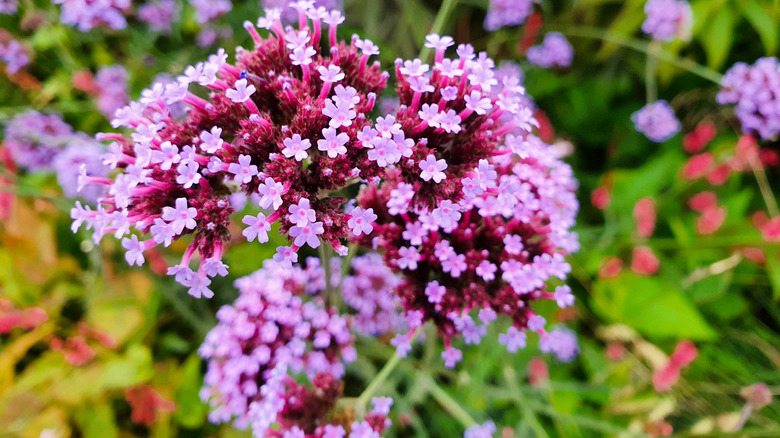
At the top of our list is verbena (Verbena officinalis). Characterized by pale purple petals and lobed leaves, verbena blooms all year round, adapts to the mid-summer drought, and looks just as good as sprouting from garden beds as it does from flower pots. Garden Design calls this flower versatile and we couldn’t agree more!
Bloom Season: spring to fall
USDA Growing zone: 9 to11
Growing Conditions: well-draining soil in a sunny, yet sheltered position
Soil Type: 5.8 to 7.2 (acidic)
Size: 1 foot in height, 2 to 5 inches wide
2. Marigold
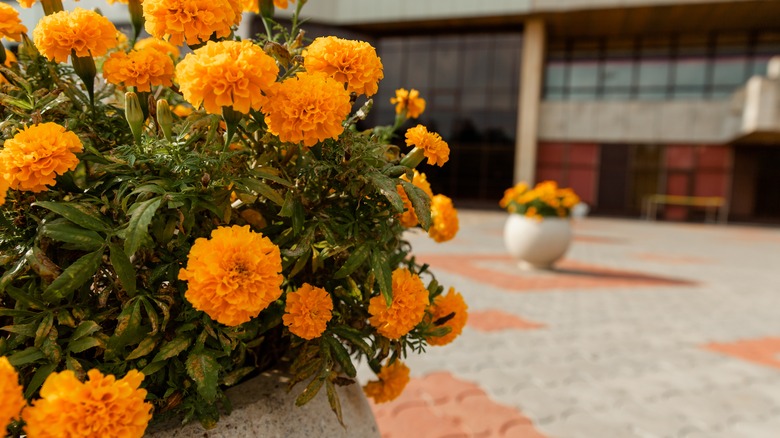
The characteristic bright orange-green color combo and inviting distinct scent aside, marigold (Tagetes) packs some real benefits. Berns Garden Center says the chief of them all is that marigold attracts insects such as ladybugs and parasitic wasps that serve as natural pest control in your garden. On top of this, Nature and Garden says marigold both heals wounds and possesses therapeutic properties in each petal that closes and opens in the direction of the sun (a sight to behold).
Bloom Season: early summer through autumn
USDA Growing zone: 2 to 11
Growing Conditions: marigolds thrive in full sun
Soil Type: preferably a sand or loam mixture
Size: 6 to 12 inches tall, 6 to 9 inches wide
3. Geranium
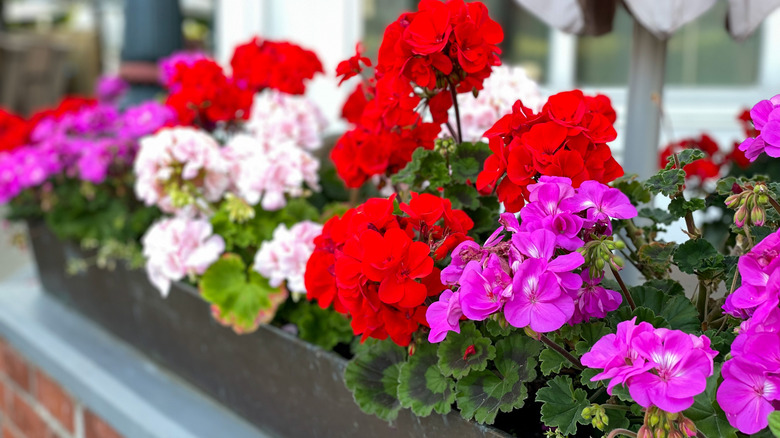
Lapa Smile/Shutterstock
Geranium (pelargonium) is a fancy famous flower aggressively farmed in the perfume industry for its scented leaves. It has impeccable heat/drought tolerance, but also repels destructive cabbage worms, Japanese beetles, spider mites, and leafhoppers from its environment, Gardening Know How writes. If you’re shooting for a vegetable garden sprinkled with pest control flowers, consider learning everything you need to know before planting Geranium.
Bloom Season: spring to fall
USDA Growing zone: 10 to 11
Growing Conditions: well-draining soils and lots of light
Soil Type: organic loam soil, preferably
Size: 4 to 48 inches tall, 6 to 36 inches wide
4. Ixora
Pooh Yuphayao/Shutterstock
Ixora (Ixora coccinea) is a frost-sensitive species recognized for showy, tiny star-like flowers that grow in clusters. According to Den Garden, a cluster may bear up to 60 ixoras which can be red, orange, yellow, or pink. When seeking an exotic beauty that doesn’t need high maintenance, ixoras may be just what you’re looking for.
Bloom Season: spring to fall
USDA Growing zone: 9 and above
Growing Conditions: full, direct sun for most of the day
Soil Type: well-draining soils and slightly acidic pH
Size: 4 to 6 feet in height
5. Petunia
TravelerFL/Shutterstock
Petunia (Petunia x atkinsiana) almost seem unreal, not just because they are super easy to grow and groom, but also because of their light-up-the-landscape abilities. And as there are four types of petunia (multiflora petunia, milliflora petunias, spreading petunias, and the grandiflora petunias, per Den Garden), you can get creative by experimenting with a combination of two or three.
Bloom Season: spring to frost
USDA Growing zone: 10 and 11 only
Growing Conditions: full sunshine
Soil Type: fertile soil with at least 25% organic matter
Size: 6 to 10 inches tall, 1 to 3 feet wide
6. Princess flower
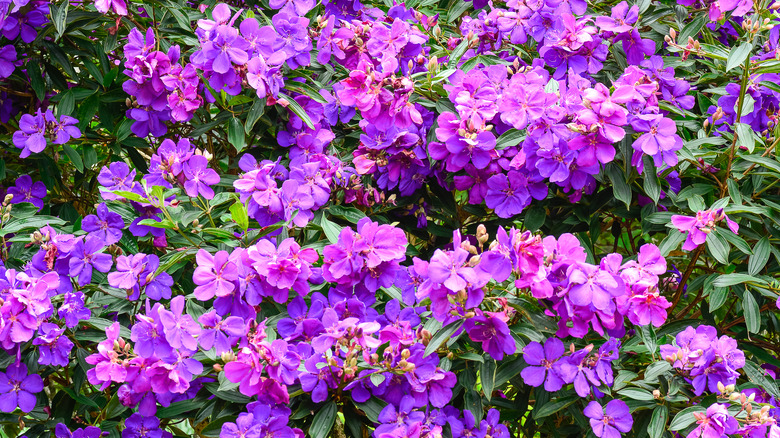
Jong 16899/Shutterstock
The princess flower (Tibouchina urvilleana) is an evergreen exotic flower that literally adds life to the garden by attracting butterflies and hummingbirds. Princess flowers can grow up to the size of a small tree, proving to be a great addition to subtropical and tropical gardens, says Gardening In South Africa.
Bloom Season: spring to winter
USDA Growing zone: 9 to 11
Growing Conditions: full to a partially sunny spot
Soil Type: rich, well-draining acidic soil
Size: 6 to 15 feet tall, 5 to 6 inches wide
7. Salvia
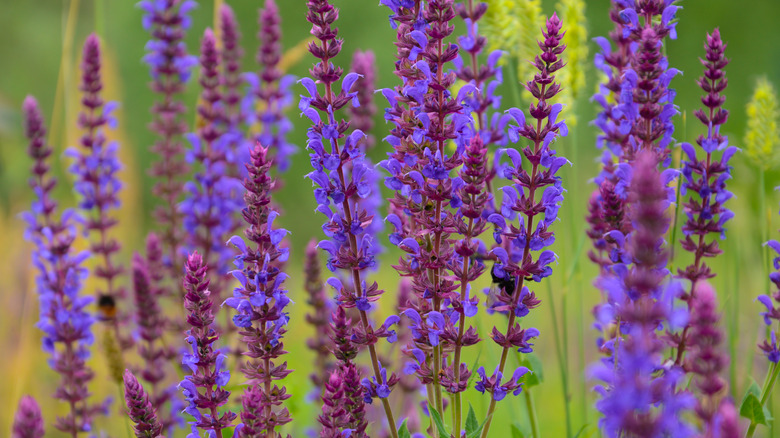
Iryna Grudyna/Shutterstock
Salvia (Salvia spp) comes in many types and sages. This perennial flower is applauded for its drought tolerance, as explained by Almanac. It blooms thrice a year and is available in a plethora of species for mixing and matching.
Bloom Season: spring, summer, fall
USDA Growing zone: 5 to 10
Growing Conditions: full sun
Soil Type: slightly acidic to neutral
Size: 12 to 24 inches tall, 9 to 18 inches wide
8. Bolivian begonia
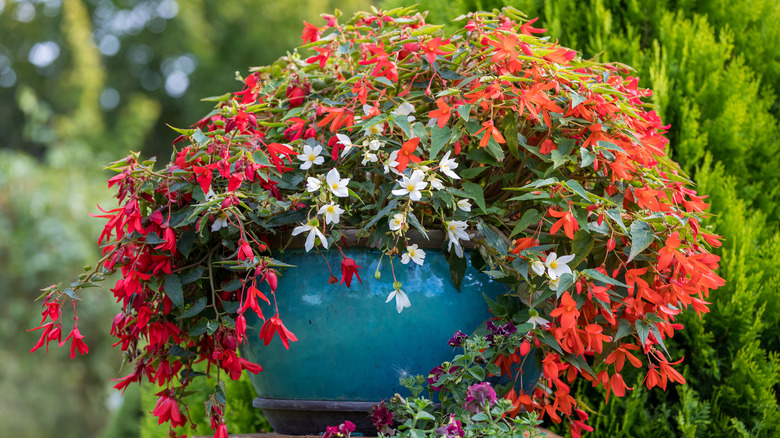
Artush/Shutterstock
Bolivian begonia (Begonia boliviensis) made this list because they are pest/disease-resistant flowers with hanging petals, setting the mood of calmness whether they’re red, white, or pink. Like Consulta Plantas says, you may choose to grow them in flower pots or garden beds. We think this is a great garden adornment especially when you have very limited bed space.
Bloom Season: late spring to early fall
USDA Growing zone: 8a to 11b
Growing Conditions: semi-shady environment
Soil Type: healthy substrate with 30% siliceous sand
Size: 6 inches to 2 feet tall, 2 feet wide
9. Million bells
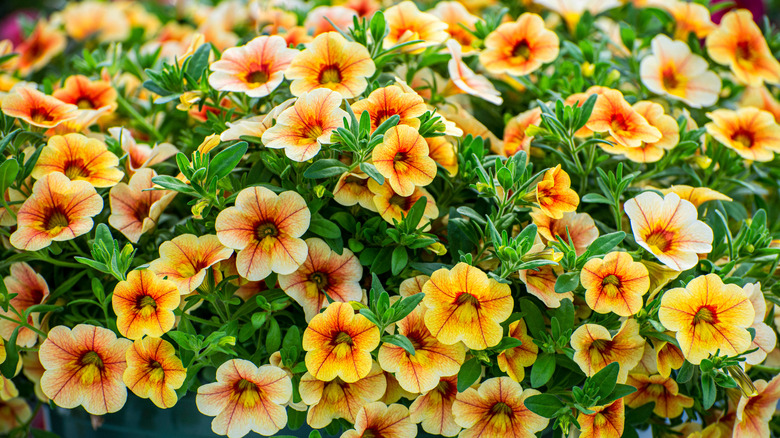
Christynat/Shutterstock
Million bells (Calibrachoa) are short-lived perennials with striking similarities to petunias. This flower isn’t too picky and thus can fully adapt to container gardens, according to Squares Gardens Centres. For this reason, million bells also make perfect indoor plants.
Bloom Season: spring to frost
USDA Growing zone: 9 to 11
Growing Conditions: full sun exposure
Soil Type: rich, moist, well-draining soil
Size: 3 to 9 inches tall, 6 to 24 inches wide
10. Bidens
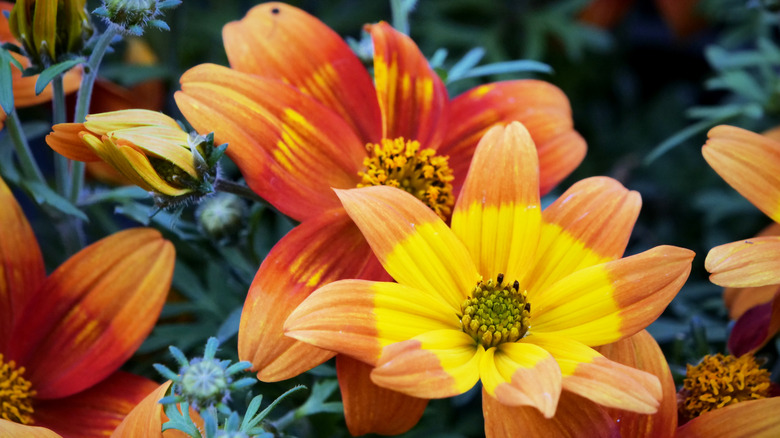
Adrian Eugen Ciobaniuc/Shutterstock
Bidens (Bidens Ferulifolia), which are also known as Spanish needles or burr marigolds among a host of other names, made our list for their easy growth and maintenance. It is mostly combined with flowers like Indian prince and California poppy.
Bloom Season: spring to fall
USDA Growing zone: 5 to 8
Growing Conditions: full sun exposure
Soil Type: well-draining light soil
Size: 24 inches tall, 18 inches wide
11. SunPatiens
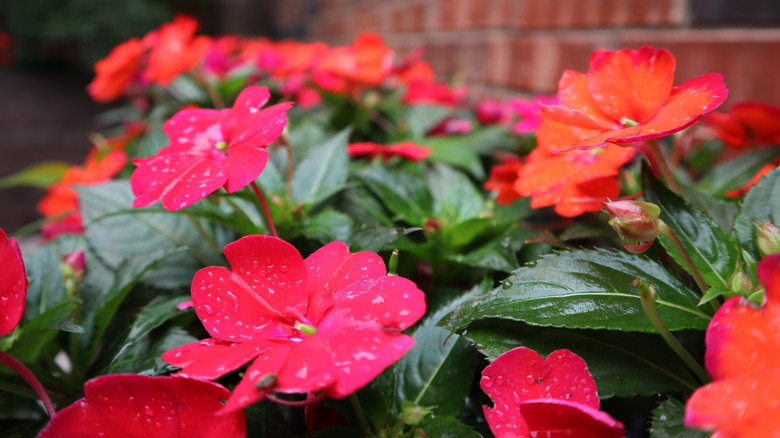
Garrett McCullough/Shutterstock
SunPatients are, yes you guessed right, sun-loving annual flowers. They adapt to the harshest weather conditions and, according to The Spruce, “deliver a brilliant show of massive color.” While we recognize that a lot of homeowners prefer planting a wide array of colors separately, we opine that they look best when blended. However, that’s entirely up to you to decide.
Bloom Season: spring to fall
USDA Growing zone: 10 to 12
Growing Conditions: full sun or partial shade
Soil Type: loamy or sandy moist and well-draining soil
Size: 16 to 34 inches tall, 14 to 21 inches wide
12. Sunflower
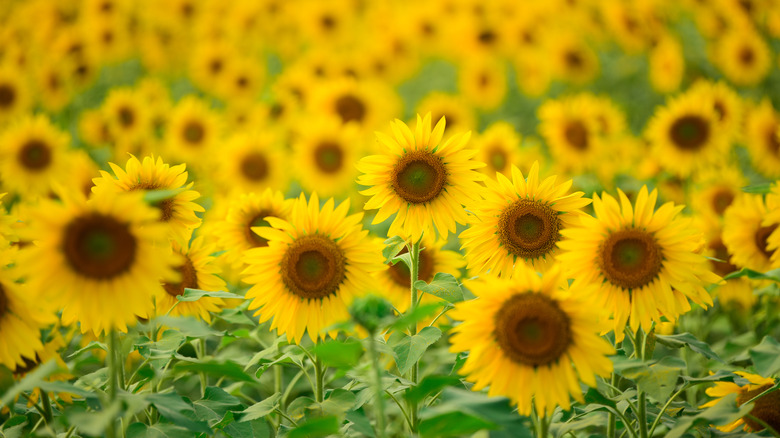
Graphic Cycle/Shutterstock
Gardening Know How writes that sunflowers (Helianthus annuus) make great garden focal points with their tall strong stems and “cherry blossoms” and well, we couldn’t agree more. However, many homeowners who plant them for their aesthetics are unaware of the gardening benefits of sunflowers such as attracting helpful pollinators, preventing weed growth, and serving as shade to other plants that require them. Pretty cool!
Bloom Season: summer to autumn
USDA Growing zone: 4 to 9
Growing Conditions: full sun exposure
Soil Type: loose, well-draining alkaline soil
Size: 5 to 10 feet tall, 1 to 3 feet wide.
13. Globe amaranth
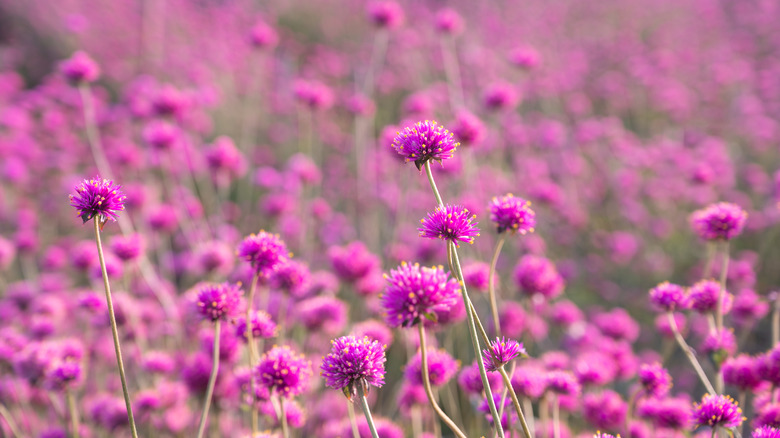
Kginger/Shutterstock
Globe amaranths (Gomphrena Globosa) are pretty, little spherical-like purple flowers that are a “pop” to your garden. This flower made our list because of its ability to reseed itself, as per The Spruce. Watching each globe pop and attract important garden pollinators on a summer evening can be satisfying.
Bloom Season: summer to frost
USDA Growing zone: 2 through 11
Growing Conditions; Full sun exposure
Soil Type: any well-draining soil
Size: 12 to 24 inches tall, 6 to 12 inches wide
14. Dwarf honeysuckle
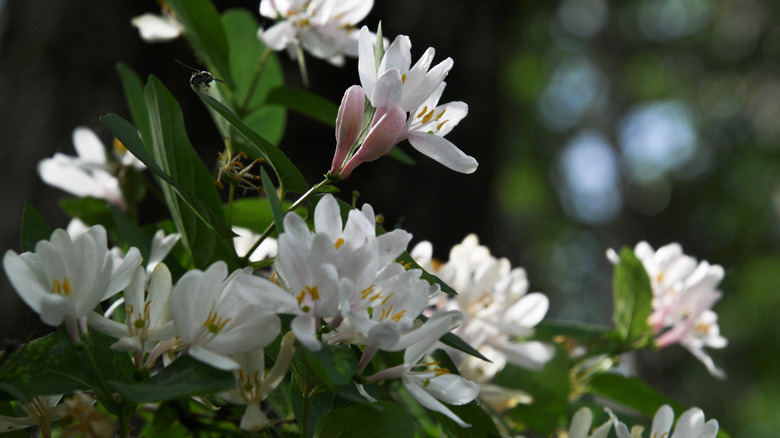
Anna Crimson/Shutterstock
Although more of a shrub than a flower, the Dwarf Honeysuckle (Lonicera xylosteum) is an attraction to bluebirds, hummingbirds, and bumblebees, as noted by Metro Blooms. This breed of flower requires very little maintenance while also serving as natural weed control in the garden.
Bloom Season: fall to winter
USDA Growing zone: 9 to 11
Growing Conditions: full sun to partial shade
Soil Type: well-draining soil
Size: 3 feet tall, 4 feet wide
15. Spider flower
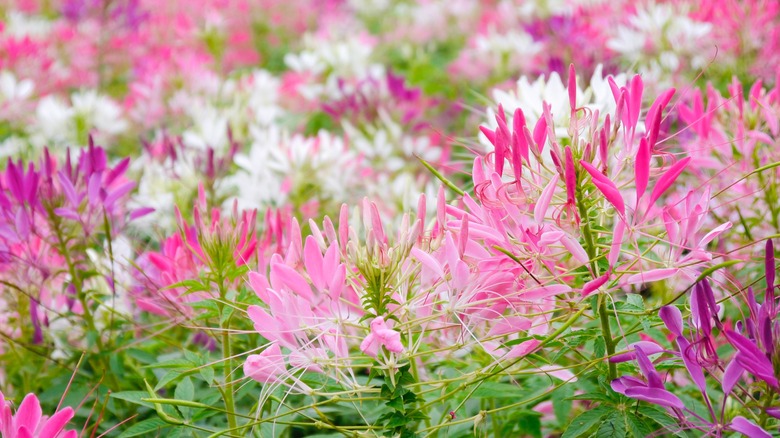
Gina Hsu/Shutterstock
Many flowers don’t thrive in hot climatic conditions, but the spider flower (Cleome Spinosa) does, per Gardenia. This flower holds up pretty well against hot summers, but also prevents pests and harmful insects. For those who want to plant sustainable vegetable gardens in a hot, dry region, spider flower is a smart selection.
Bloom Season: summer
USDA Growing zone: 10 to 11
Growing Conditions: partial sun
Soil Type: average, well-draining soil
Size: 1.5 to 5 feet tall, 2 feet wide
16. Blanket flower
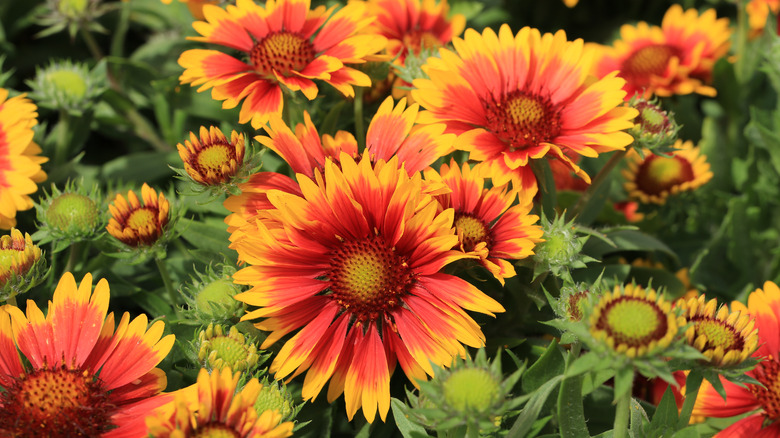
Traveller70/Shutterstock
We at House Digest recommend blanket flowers (Gaillardia) to those who live in drier, hotter areas and want a uniquely snazzy garden ripe with drought tolerant flowers that are easy to maintain. Though available in a hue of bright blossoming colors (red, orange, yellow, pink), blanket flowers are slightly toxic to humans (known to cause skin irritation upon contact), according to The University of Texas at Austin.
Bloom Season: summer to fall
USDA Growing zone: 3 to 10
Growing Conditions: full sun exposure
Soil Type: any well-draining soil that isn’t clay soil
Size: 12 to 18 inches tall, 12 to 24 inches wide
17. Pentas
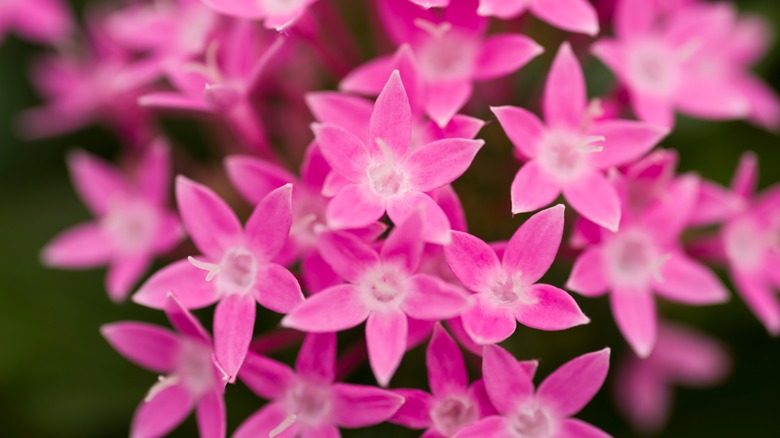
zzz555zzz/Shutterstock
Pentas (Pentas lanceolata) are generally planted for their ability to attract pollinators into your garden. Looking like pink stars, pentas demand low maintenance, save frequent trimmings here and there, as noted by the Missouri Botanical Garden. If your main garden goal is to add dopeness, brightness, and butterflies to your landscape, pentas does it effortlessly.
Bloom Season: spring
USDA Growing zone: 5 to 7
Growing Conditions: full sunshine
Soil Type: well-draining
Size; 3 to 6 inches tall, 12 inches wide
18. Common lantanas
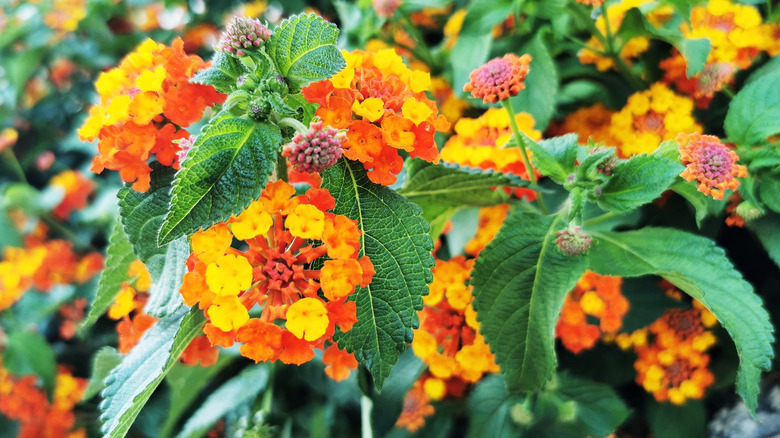
Oakland Images/Shutterstock
Common lantanas (Lantana Camara) are one of the few kinds of flowers that come in color blends. Now, here is the plus side to that: They pop. They possess a citrus smell and thus attract bumblebees and butterflies to your garden, SnaPlant writes. Whenever the work break or holiday isn’t long enough but you still need to breath your garden to life, common lantanas is a fast-growing perennial that’s easy to maintain.
Bloom Season: all year round (thrives the most in frost-free climates)
USDA Growing zone: 7a to 11a
Growing Conditions: full sunshine
Soil Type: well-drained soil
Size: 6 feet high, 6 feet wide
19. Veronica
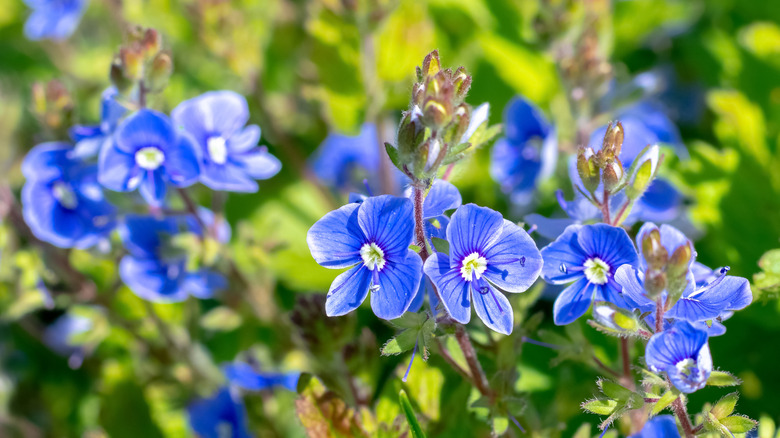
MVolodymyr/Shutterstock
Veronica (Veronica chamaedrys), locally known as Germanda Speedwells, are creeping flowery plants that naturally grow on roadside verges — so much so that travelers in years gone by know them as good luck plants, according to The Wildlife Trusts. With long, spiked tiny flowers on hairy stems, veronicas are great for garden markers in white, pink, blue, or purple. We suggest adding them to your low-maintenance garden flowers list too.
Bloom Season: early summer to late summer
USDA Growing zone: 3 to 8
Growing Conditions: full sun exposure
Soil Type: average, well-draining soil
Size: 9 to 20 Inches tall, 0.3 to 0.5inches wide
20. Tall garden phlox
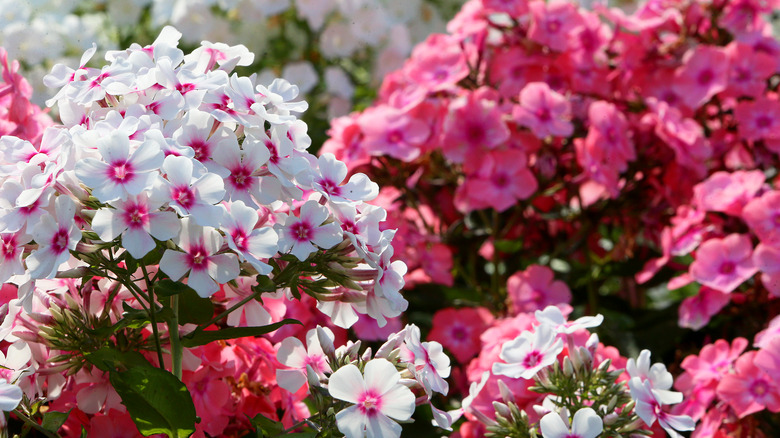
Ramil_Nasibulin/Shutterstock
This list would have been incomplete without the tall garden phlox (Phlox paniculata). According to The Spruce, Tall Garden Phlox adds “interest” to summer gardens. However, we at House Digest believe you would be more interested in their charm for hummingbirds, not to mention their sturdy stems, which help prevent weed spread and growth.
Bloom Season: summer
USDA Growing zone: 4 to 8
Growing Conditions: full to partial sun exposure
Soil Type: moist but well-draining soil with a neutral pH
Size: 2 to 4 feet tall, 2 to 3 feet wide
21. Russian sage asters
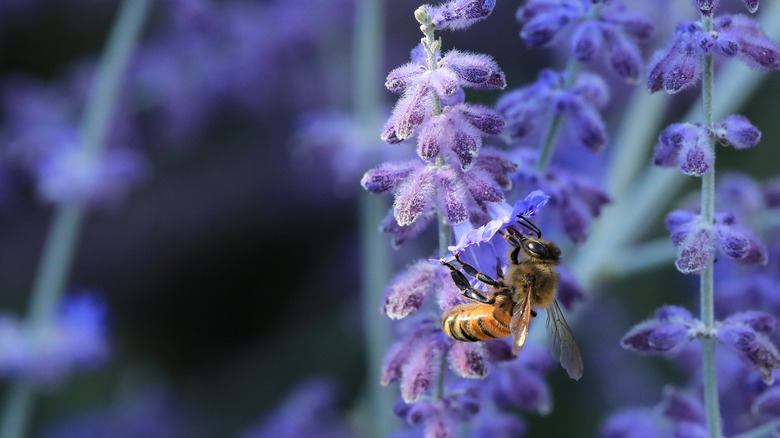
Harold Stiver/Shutterstock
Busy lifestyle? No worries. Russian sage asters (peroviskia atriplicfolia) can be completely ignored for weeks, Nick’s Garden Center writes, without losing the attractiveness of their first-day blossom. Though a late bloomer in Spring, this flower steers deer off your yard while attracting wasps and hummingbirds.
Bloom Season: summer
USDA Growing zone: 5 to 9
Growing Conditions: full sun exposure
Soil Type: medium, dry, or well-draining soil
Size: 3 to 5 feet tall, 2 to 4 feet wide
22. Astilbe
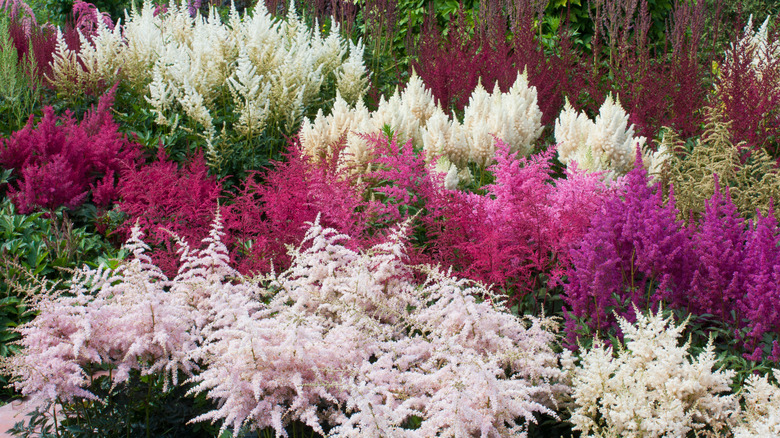
znmystery/Shutterstock
Astilbe (Astilbe chinensis) makes our list, thanks to their long-term blooms and airy foliage. According to Longfield Gardens, the only downside to them is how much of a painfully slow bloomer they are. However, once they are established, they are a joy to have around.
Bloom Season: spring to summer
USDA Growing zone: 3 to 8
Growing Conditions: partial shade
Soil Type: loamy soil
Size: 6 inches to 2 feet tall, 6 inches to 5 feet wide
23. Switchgrass
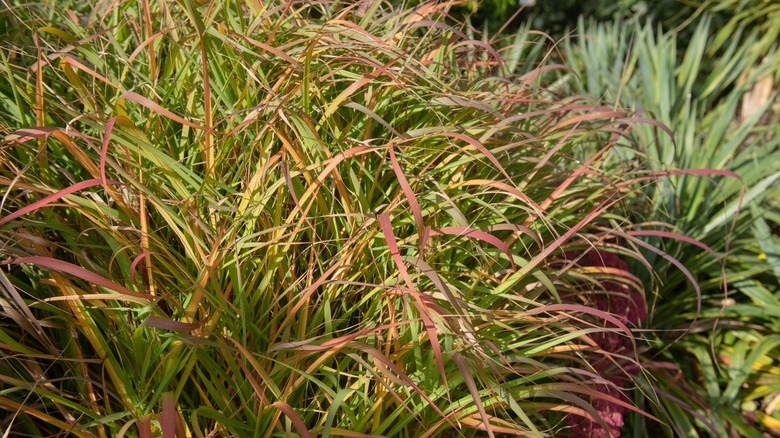
Peter Turner Photography/Shutterstock
While Switchgrass (aka Panicum Virgatum) doesn’t fall into a conventional flower category, it has made our list because it’s an ornamental, deciduous, perennial grass just like pampas grass. That’s why Hoffman Nursery calls it “adaptable clump-forming prairie grass that adds interest all year round.” We recommend switchgrass as an alternative to the regular greens because it changes color all year round, setting the right mood for each season. Even better, switchgrass is scientifically proven to minimize erosion, a great asset when gardening in a frequently flooded environment.
Bloom Season: summer
USDA Growing zone: 3 to 9
Growing Conditions: shade
Soil Type: moist clay or sandy soil
Size: 4 to 6 feet tall, 2 to 3 feet wide
24. Peony
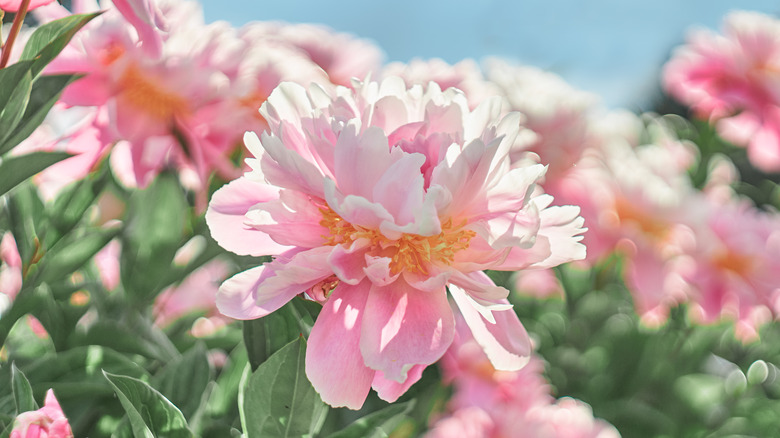
Serhii Brovko/Shutterstock
Peonies (Coreopsis) are super cute exotic blooms. They come in shades of shapes, sizes, and types. Aromatic? Yes. Requires a lot of care and attention? Yes. Beware, peony mildly contains toxins that, when ingested by pets or humans, cause vomiting and diarrhea, as Pet Poison Helpline warns.
Bloom Season: late spring to late summer
USDA Growing zone: 6 to 7
Growing Conditions: full sun exposure
Soil Type: well-draining soil
Size: 18 to 24 inches tall, 6 to 8 inches wide
25. Siberian iris
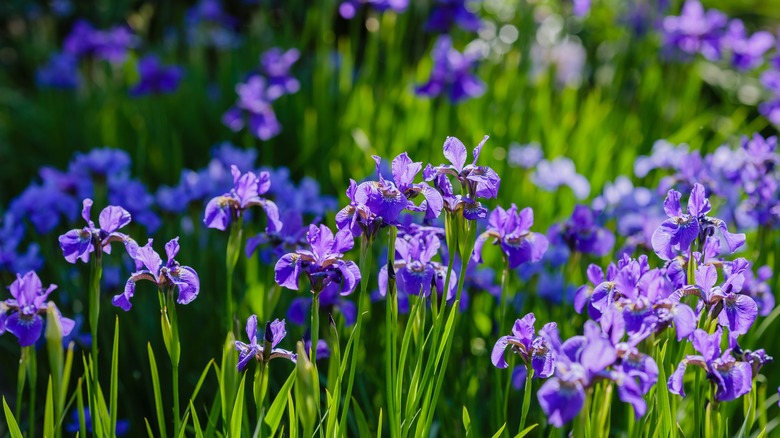
Flower_Garden/Shutterstock
Ahh, the Siberian iris (Iris Sibirica), modest yet classy flowers with each petal looking like a butterfly about to take a flight. According to The Spruce, this flower makes up for its lack of dazzle by being easy to grow, pest resistant, and drought tolerant. They come in blue, purple, violet and even white!
Bloom Season: May
USDA Growing zone: 3 to 9
Growing Conditions: partial shade
Soil Type: a blend of average moisture, rich and well-draining soil
Size: 3 to 12 inches tall, 6 to 12 inches wide
26. Penstemon
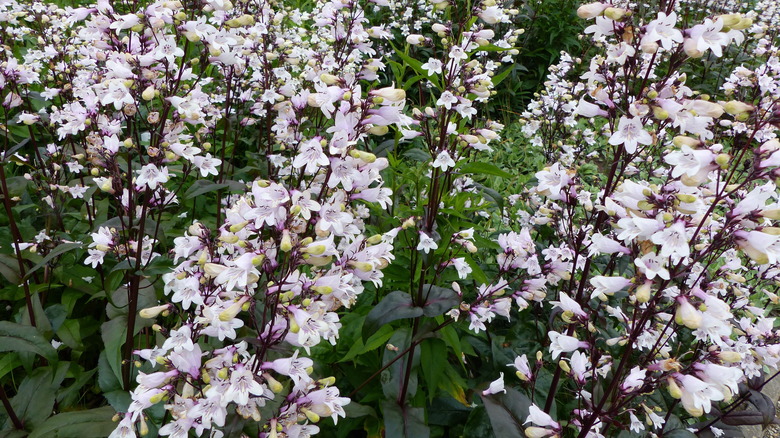
guentermanaus/Shutterstock
Penstemon (Penstemon digitalis) is termed beard tongue with respect to its sterile stamen that shoots “bearded” or “small hair tuft” stalks. And guess what? Penstemon flowers are of immense value, so much so that two men got charged with stealing 600 pounds of seeds (don’t laugh, please). According to The Natural Web, Penstemons are beauty-endowed perennials.
Bloom Season: spring to early summer
USDA Growing zone: 3 to 8
Growing Conditions: full sunshine
Soil Type: well-draining
Size: 6 to 8 feet tall, 8 to 20 inches wide
27. Scabossia
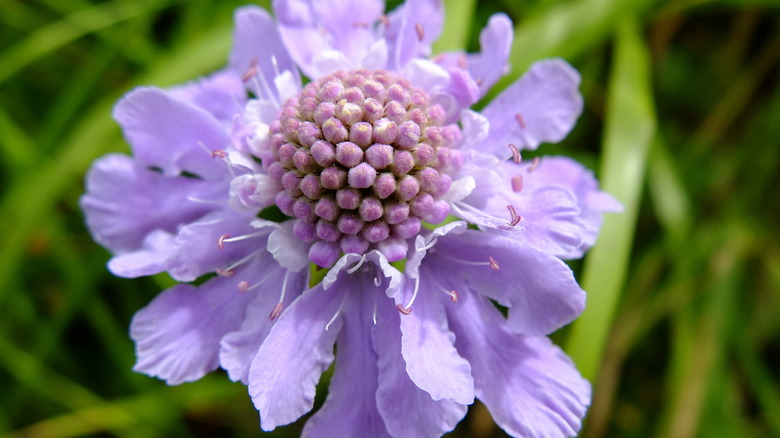
YukoF/Shutterstock
Scabossia, butterfly blue, or just call them pincushion (Scabiosa Japonica), are small but mighty, clump-forming, perennial flowers for making paths and edging borders in the garden, Gardenia writes. Pincushion flower is also easy to grow. In the early stages, throw in the same care you’ll give to a baby until the blooming period when they can take care of themselves
Bloom Season: summer to early fall
USDA Growing zone: 3 to 7
Growing Conditions: full sun exposure
Soil Type: moist but well-draining soil
Size: 12 to 18 inches tall, 12 to 18 inches wide
28. Black-eyed Susan
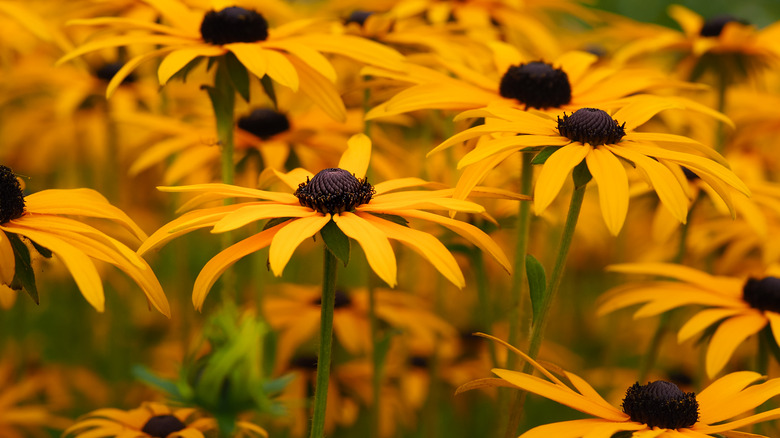
AngieC333/Shutterstock
We absolutely love the black-eyed Susan (rudbeckia hirta). Their perfect blend of a dark center and bursts of yellow petals can make the dreariest of days lively (If you truly love flowers). This flower made it to our list because they grow really fast, though they are, unfortunately, susceptible to leaf spots and powdery mildew, according to SF Gate.
Bloom Season: summer
USDA Growing zone: 3 to 7
Growing Conditions: full sun exposure
Soil Type: moist to dry, well-draining
Size: 2 to 3 feet tall, 1 to 2 feet wide
29. Aconite
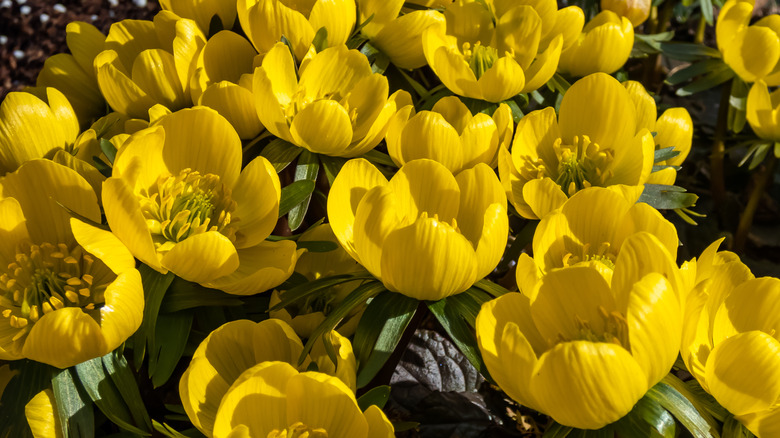
Kristine Rad/Shutterstock
Frankly, aconite (Eranthis Hyemalis) sounds like some dreary raw material or a perhaps gemstone, but it’s not: Aconite is one of the most colorful flowers you will ever come across, though can be toxic to humans and animals. These golden, buttercup-like flowers (also called winter aconite) are charming, low-maintenance, herbaceous perennials, says Nature And Gardens.
Bloom Season: spring
USDA Growing zone: 3 to 7
Growing Conditions: full sun exposure
Soil Type: well-draining soil
Size: 3 to 6 inches tall, 6 inches wide
30. Madonna lily
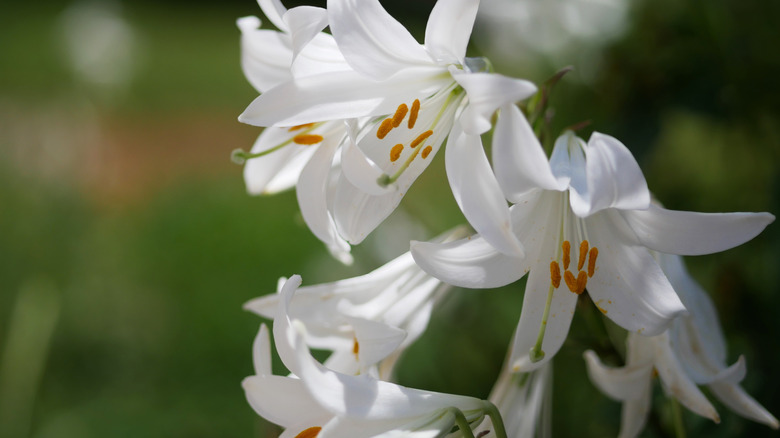
Sia Sia/Shutterstock
The Madonna lily (Lilium candidum) is an ornamental plant that has been cultivated for over 3,000 years, says Google Arts & Culture. Hats off to super elegant features, Madonna lily is characterized by trumpet-shaped, white blooms with a yellow interior. Yes, a flower this good requires a lot of care, but Fragrantica says the fragrance of “early days of spring” it emits will make all the work look so little.
Bloom Season: spring to midsummer
USDA Growing zone: 5 to 9
Growing Conditions; partial shade
Soil Type: rich, organic well-draining soil
Size: 4 to 6 feet tall, 1 to 2 feet wide
31. Bergenia
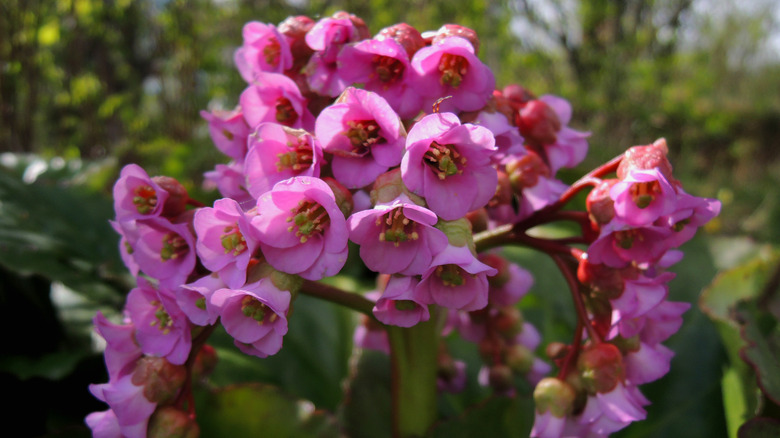
Dajra/Shutterstock
Bergenia (Bergenia Cordifolia) is a cluster of brightly picked petals with a darker shade in the middle. These flowers are attractive on their own, but they reach their peak in April and you will be glad you planted them. Local Gardner explains that they are also called pig squeaks because of the sound they produce when they are rubbed together.
Bloom Season: April to May
USDA Growing zone: 4 to 8
Growing Conditions: part shade to full shade
Soil Type: moist and rich clay or loam
Size: 6 to 12 inches tall, 12 to 18 inches wide
32. Comfrey
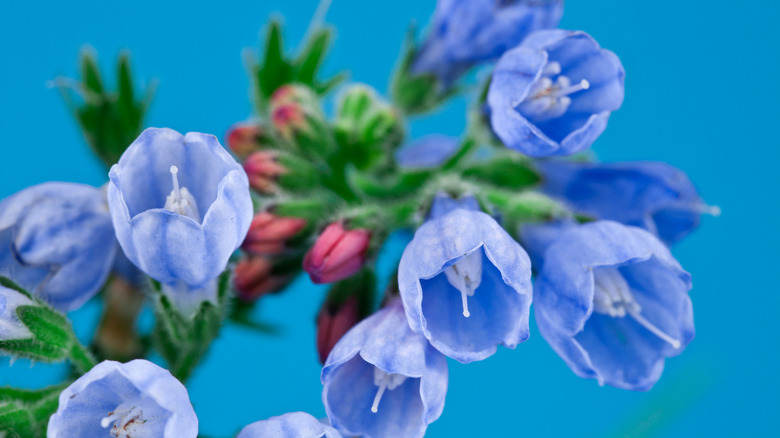
Snowbelle/Shutterstock
Comfreys (Symphytum) are tall perennial plants which we’re recommending for their shrub and bell-like flowers that are perfect for a blend of blue colors, bursting hither and thither. When used as should, you can create fertilizer out of comfreys for your vegetable garden. It is noteworthy that comfrey can cause liver damage or failure when ingested, WebMD warns.
Bloom Season: spring
USDA Growing zone: 3 to 9
Growing Conditions: full sun to partial shade
Soil Type: loamy soil
Size: 12 to 36 inches tall, 9 to 30 inches wide
33. Daffodils
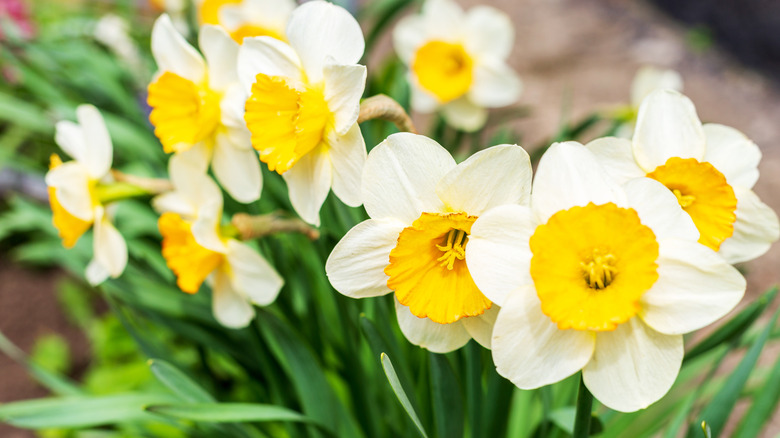
Viktoriia Lozova/Shutterstock
For the love of Daffodils (Narcissus), William Wordsworth wrote the poem “I Wandered Lonely as a Cloud.” Perhaps he did so because these flowers are not fussy about soil types and will easily bloom again year after year if you apply the tips shared by Hayes Garden World.
Bloom Season: spring
USDA Growing zone: 3 to 8
Growing Conditions: partial sun
Soil Type: neutral or slightly acidic, well-draining soil
Size: 6 to 30 inches tall, 6 to 12 inches wide
34. Becky Shasta daisies
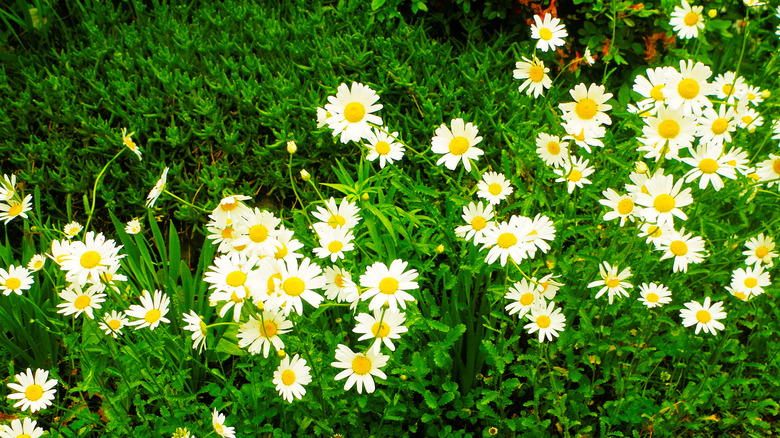
ajisai13/Shutterstock
Becky Shasta daisies (Leucanthemum) are hot — literally, so they brighten up your garden in the heat of summer, Dave’s Garden explains. Becky Shasta daisies boast classic white daisy blooms and central yellow disks. Looking for rapid-growth flowers with astonishing beauty? Go for Becky Shasta.
Bloom Season: summer
USDA Growing zone: 5 to 9
Growing Conditions: full sun
Soil Type: well-draining
Size: 3 to 4 feet tall, 2 to 3 feet
35. Roses
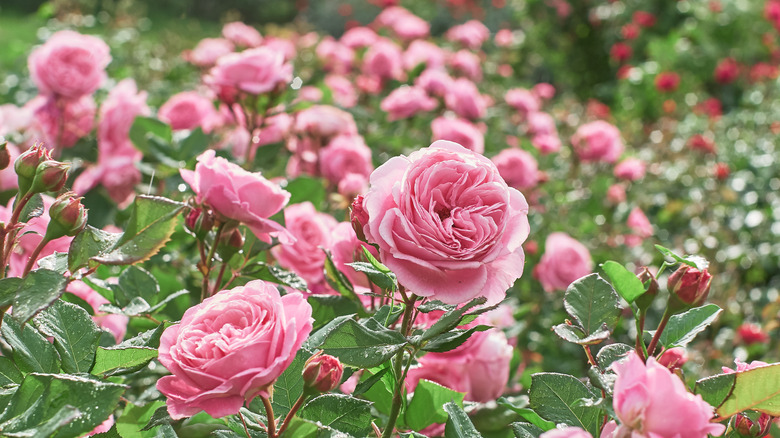
Serhii Brovko/Shutterstock
Growing the fairytale flower, roses (Rosa), is relatively easier than you might have thought. Of course, you wouldn’t neglect them like you would other flowers, but maintenance is not that difficult either. Garden Design says anyone can cultivate roses successfully, how true.
Bloom Season: mid-spring to fall
USDA Growing zone: 7 to 9
Growing Conditions: full sunlight
Soil Type: loam soil
Size: varies
36. Nasturtium
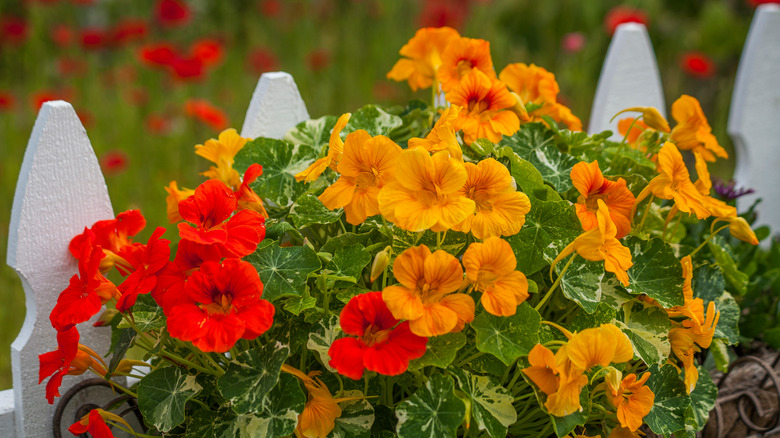
Danita Delimont/Shutterstock
You can never “grow wrong” with nasturtium (Tropaeolum), which is one of the most versatile flowers around with edible leaves, according to Gardening Know How. Where are the lazy gardeners? The nasturtium thrives on neglect, and so all you may need to do is admire its blooms! FYI, there are about 80 different varieties of nasturtium (via Gardner’s Path,) so you may want to carefully select the ones that pique your interest.
Bloom Season: May to September
USDA Growing zone: 2 to 11 (annual)
Growing Conditions: full sun exposure
Soil Type: average, medium well-draining soil
Size: 1 to 10 feet tall, 1 to 3 feet wide
37. Maiden pink
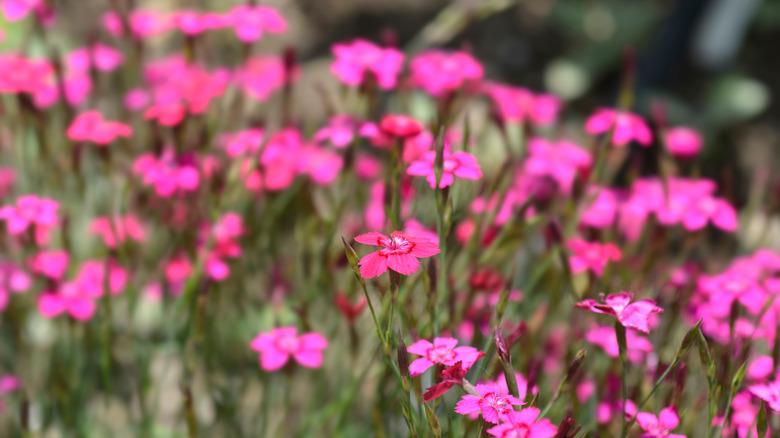
Nahhana/Shutterstock
Maiden pink (Dianthus Deltoides) is scentless, according to Plantlife, and that is the reason we have included it on this list for folks who are allergic. Maiden pink is a lovely thing capable of thriving well in flowerbeds and even in flower pots, Home Stratosphere explains. Although they are not invasive, they require being tended to from time to time, but then it’s for the best results.
Bloom Season: late spring and summer
USDA Growing zone: 3 to 11
Growing Conditions: full sun exposure
Soil Type: well-drained chalk, sand, or loam soil
Size: 6 to 8 inches to 1 foot tall
38. Leadwort
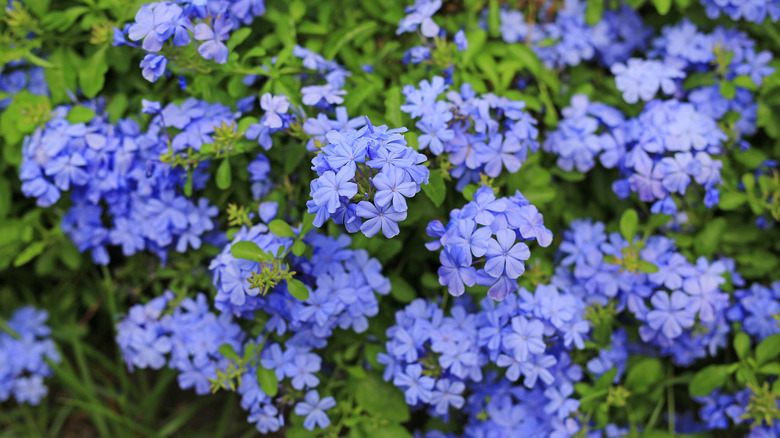
Golfx/Shutterstock
The name sounds repulsive, we are aware, but leadwort (ceratostigma plumbaginoides) is one of the most attractive perennials you could ever come across. Making it to the list, thanks to a feminine aesthetic appeal, this flower can survive a vast majority of gardening conditions and requires a reasonable amount of care, Better Homes & Gardens writes.
Bloom Season: summer to fall
USDA Growing zone: 5 to 9
Growing Conditions: full to partial sun exposure
Soil Type: well-draining soil
Size: 6 to 12 inches tall, 12 to 18 inches wide
39. Purple coneflowers
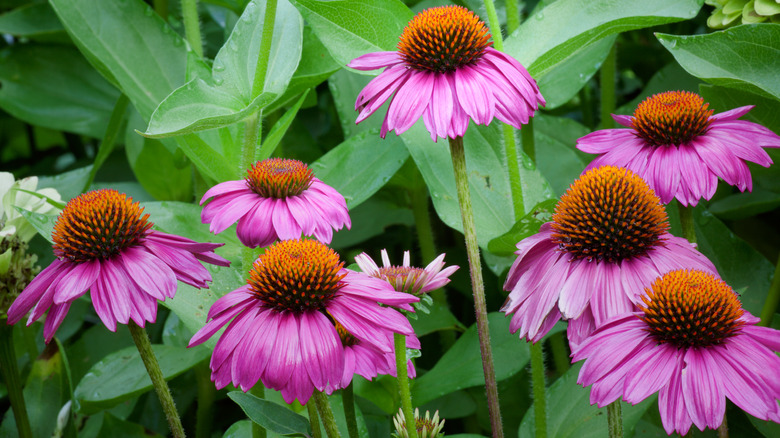
Christopher Aquino/Shutterstock
If you are a fan of bright colors, grow purple coneflowers (Echinacea purpurea) in your garden. Again, you can never grow wrong. These flowers, American Meadows points out, attract hummingbirds, which help reseed the flower and other plants in the garden. These flowers have fibrous roots which make them adaptable to any kind of garden situation.
Bloom Season: summer
USDA Growing zone: 3 to 8
Growing Conditions: full sun and partial shade
Soil Type: well-draining, neutral or acidic soil
Size: 2 to 5 feet tall, 1 to 2 feet wide
40. Lilies
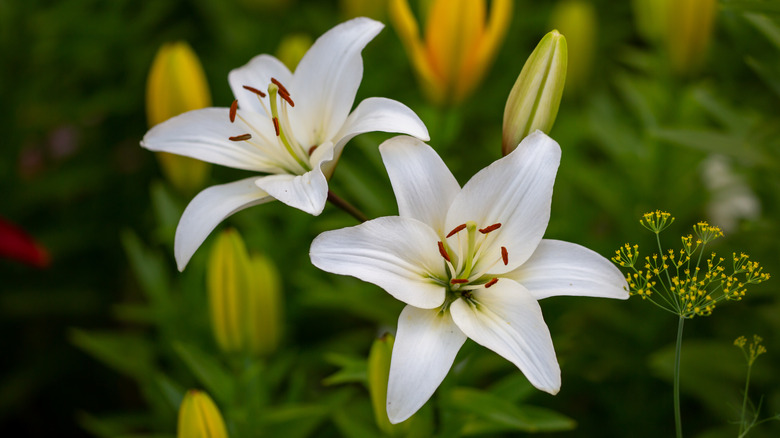
Anton Nikitinskiy/Shutterstock
Lilies (Lilium) are common in summer gardens, per Garden Design, and are widely used in the body care industry. With dazzling, beauteous petals pumping fragrance into the air, lilies are satisfying to tend to even though they require a lot of care to hit their peak look. The good thing is there’s a bunch of types of lilies to choose from.
Bloom Season: summer
USDA Growing zone: 5 to 8
Growing Conditions: full sun
Soil Type: well-draining soil
Size: 2 to 5 feet tall, 1 foot wide


